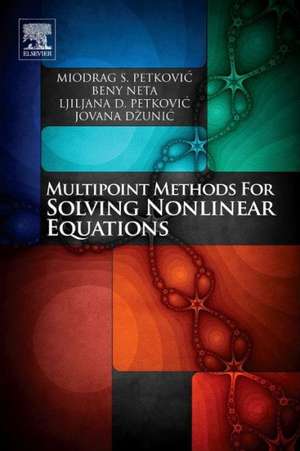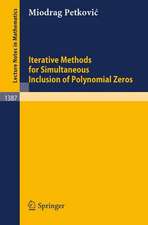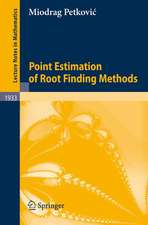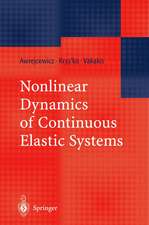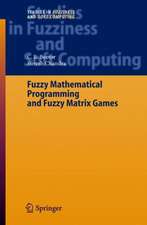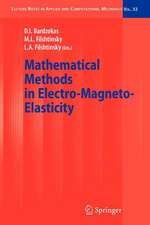Multipoint Methods for Solving Nonlinear Equations
Autor Miodrag Petkovic, Beny Neta, Ljiljana Petkovic, Jovana Dzunicen Limba Engleză Hardback – 4 feb 2013
Multipoint methods are of great practical importance, as they determine sequences of successive approximations for evaluative purposes. This is especially helpful in achieving the highest computational efficiency. The rapid development of digital computers and advanced computer arithmetic have provided a need for new methods useful to solving practical problems in a multitude of disciplines such as applied mathematics, computer science, engineering, physics, financial mathematics, and biology.
- Provides a succinct way of implementing a wide range of useful and important numerical algorithms for solving research problems
- Illustrates how numerical methods can be used to study problems which have applications in engineering and sciences, including signal processing, and control theory, and financial computation
- Facilitates a deeper insight into the development of methods, numerical analysis of convergence rate, and very detailed analysis of computational efficiency
- Provides a powerful means of learning by systematic experimentation with some of the many fascinating problems in science
- Includes highly efficient algorithms convenient for the implementation into the most common computer algebra systems such as Mathematica, MatLab, and Maple
Preț: 721.10 lei
Preț vechi: 987.81 lei
-27% Nou
Puncte Express: 1082
Preț estimativ în valută:
138.00€ • 143.54$ • 113.93£
138.00€ • 143.54$ • 113.93£
Carte tipărită la comandă
Livrare economică 14-28 aprilie
Preluare comenzi: 021 569.72.76
Specificații
ISBN-13: 9780123970138
ISBN-10: 012397013X
Pagini: 344
Dimensiuni: 152 x 229 x 18 mm
Greutate: 0.56 kg
Editura: ELSEVIER SCIENCE
ISBN-10: 012397013X
Pagini: 344
Dimensiuni: 152 x 229 x 18 mm
Greutate: 0.56 kg
Editura: ELSEVIER SCIENCE
Public țintă
Research Professionals, Scientists, Engineers, Mathematicians, Graduate StudentsCuprins
1 Basic concepts2 Two-Point methods3 Three-Point non-optimal methods4 Three-Point optimal methods5 Higher-order optimal methods6 Multipoint methods with memory7 Simultaneous methods for polynomial zeros
Recenzii
"...a unified and comprehensive description of the existing root-finding methods…recommended to all those who want to find their way in the jungle of the immense number of different methods and classes of methods, which are intended to determine the roots of a scalar nonlinear equation." --Mathematical Reviews, Multipoint Methods for Solving Nonlinear Equations
"The authors are concerned with the approximate determination of simple and multiple zeros of real-valued functions of one real variable except for the last chapter which is devoted to the computation of simple and multiple (real and complex) zeros of polynomials…Quite a number of numerical examples are included to demonstrate the computational quality of the methods presented." --Zentralblatt MATH
"The authors examine and explain multipoint methods, starting with two-points and progress to three-point non-optimal and optimal methods. They then turn to higher-order optimal methods, multiple points with memory, and close with simultaneous methods for polynomial zeros." --Reference and Research Book News, October 2013
"The authors are concerned with the approximate determination of simple and multiple zeros of real-valued functions of one real variable except for the last chapter which is devoted to the computation of simple and multiple (real and complex) zeros of polynomials…Quite a number of numerical examples are included to demonstrate the computational quality of the methods presented." --Zentralblatt MATH
"The authors examine and explain multipoint methods, starting with two-points and progress to three-point non-optimal and optimal methods. They then turn to higher-order optimal methods, multiple points with memory, and close with simultaneous methods for polynomial zeros." --Reference and Research Book News, October 2013
